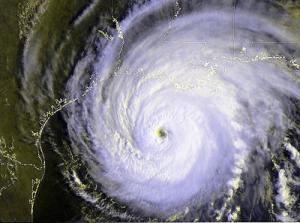PreparednessHurricane lessons: Lamar U has developed contingency plans for its contingency plans
The idea of a contingency plan for a contingency plan would strike most people as somewhat silly, and most others as wasting time in a situation where time is a critical. For some time, the military has taught that when disaster strikes, the most effective means of calming one’s self is to perform a routine act, such as tying one’s shoe lacing, grading papers, or, in the case of the military, cleaning a weapon. The objective is to settle down in order to make a rational evaluation of the situation, and plan accordingly. The leaders of Lamar University, in Beaumont, Texas, reached the same conclusions after Hurricane Rita came roaring through the campus, and the university was sent reeling from $50 million in damage from the storm, which exposed the shortcomings of the school’s preparedness plans.

Hurricane Rita reaching the Texas coast // Source: commons.wikimedia.com
The idea of a contingency plan for a contingency plan would strike most people as somewhat silly, and most others as wasting time in a situation where time is a critical.
For some time, the military has taught that when disaster strikes, the most effective means of calming one’s self is to perform a routine act, such as tying one’s shoe lacing, grading papers, or, in the case of the military, cleaning a weapon. The objective is to settle down in order to make a rational evaluation of the situation, and plan accordingly.
The activity can be anything, the only requirement is that the activity is as mundane and normal as possible. Paired with advance preparation, this combination will yield optimal results.
Such was the case at Lamar University, in Beaumont, Texas, after Hurricane Rita came roaring through the campus. The university was sent reeling from $50 million in damage from the storm, which exposed the shortcomings of the school’s preparedness plans. These deficiencies in emergency preparedness threatened to up-end students’ lives.
That looming threat was not only cancellation the remaining classes of the semester, but the graduation of the senior class because they would not be able to finish their curricula.
After ten years, those who are still employees of the university recall how faculty, administration, maintenance workers, and even alumni came together to solve the difficult problem of ensuring the senior class would be able to graduate.
The Beaumont Enterprise reports that three years later, structural changes made after Hurricane Rita alleviated some of the challenges posed by Hurricane Ike and are expected to help the university the next time a major storm strikes that part of Texas.
Emergency generators will start immediately, and department’s two sub-zero freezers have power, officials said.
On campus, eighty buildings that had sustained roof damage, flooded. Water rushing into these buildings fouling carpets and ceiling tiles, said Mike Hogan, the university’s senior director of project management.
Five to six university officials boarded with Jerry Simmons, then the president of the university, at his on-campus house for weeks after the storm, Simmons said. Lacking computers, they mapped out on an easel the building issues that needed to be resolved.
Workers had to get the school’s 1,000 dorm rooms and classrooms into working shape, which meant replacing carpets, repainting walls, scrubbing mold, fixing ceilings, and hanging blue tarps on roofs.
It was so much work to do in such a short period of time that Simmons feared he would have to cancel the semester, similar to what happened in New Orleans after Hurricane Katrina, said Cruse Melvin, the university’s vice president for finance and operations. The blow would have been crippling to Lamar, which noticed a dip in attendance after the storm, he said.
“I think the president’s view was that it could be a death blow,” Melvin said. “You could lose half your students and not get them back.”
Ten years later, every class section at Lamar has the capability of teaching and communicating with students forced to leave campus. Advances in technology have made course continuation possible.
Commonplace today, remote learning was not available at Lamar when Hurricane Rita struck. Jena Still, a then-senior studying communication disorders, had returned to work but feared she would lose a semester of school. It was all or nothing.
“We were all really concerned about graduating on time,” Still said.
Simmons said canceling the semester was “absolutely” a consideration in restarting classes.
“I had been visiting with the [Texas State University system] chancellor anticipating a major shutdown,” Simmons said. The system authorized contract laborers to help rehabilitate the campus, allowing students to return after missing more than three weeks of classes. “We were pretty close, to the point if we would have gone on much longer, we would have to abandon the semester.
“That graduation was one of the most joyous graduations in our history,” Simmons said.
